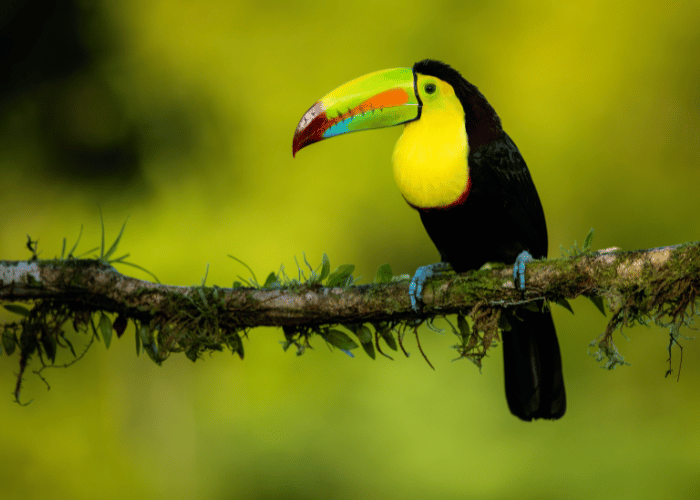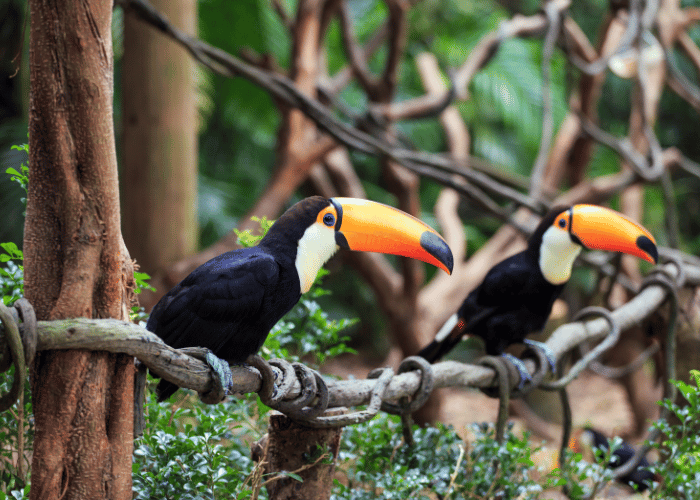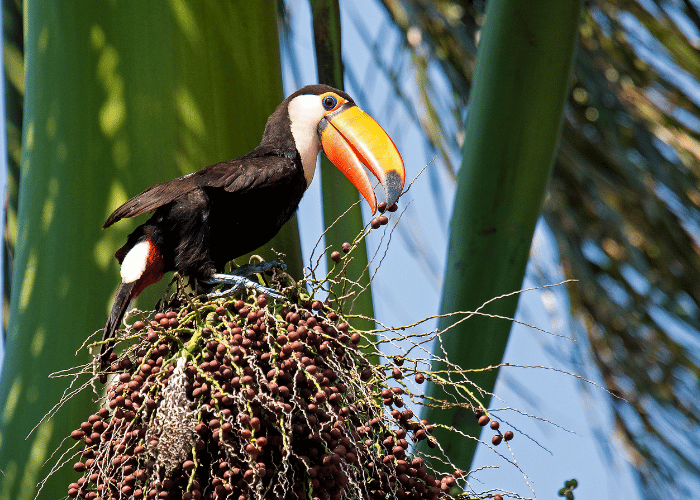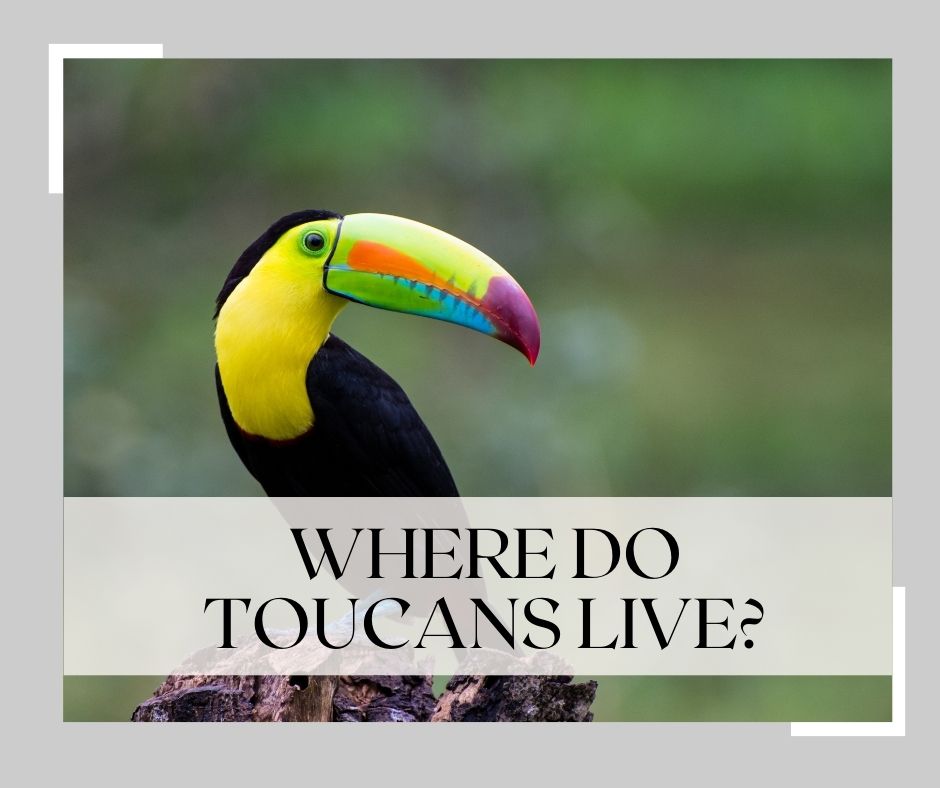Where Do Toucans Live
Table of Contents
You’ve probably found the unique, colorful appearance of toucans captivating just like I have. With their large, bill-shaped mouths and vibrant plumage, they’re hard to ignore. But where do these exotic birds actually hang their hats? Fret not my curious friend, I’ve been digging around a bit and I’ve got some answers for you.
Toucans call the tropical forests of Central and South America home. These forests provide a perfect backdrop for their life, drenched in the warm, moist climate they relish. Always perched up high in the rainforest canopies, they enjoy a bird’s-eye view (pun intended!) of their surroundings.
Often, you’ll find these chirpy birds living in groups, referred to as flocks. They’re social creatures, you know. Safety in numbers and all that. Plus, it’s always better to have some friends around when you’re sharing your tropical apartment in the trees!

An Overview on Toucans: Know Your Species
So, we’re talking about toucans today, huh? I’m stoked! If you’ve ever seen a bird with an oversized, colorful beak and thought, “Wow, that’s unusual,” you’ve probably spotted a toucan in the wild, or perhaps in a nature documentary. You know, these birds are as fascinating as they look!
Let’s plunge in. But first, a bit about their classification. Toucans belong to the Ramphastidae family. There’s up to about 40 different species of toucans. And boy, aren’t they all exquisite! The species differ mostly in size and coloration, meaning there are many variations on the theme!
| Size Range | Weight Range |
|---|---|
| 14-23 inches | 130-680 grams |
The range above gives you a slight idea of the physical stats you can expect from the existing species. Keep in mind, though, that the toucan’s beak can reach up to about 9 inches alone!
- The Toco Toucan, a crowd favorite, boasts a predominantly black body with a striking white throat. Outlined by a blue ring, their orange beak is almost hard to miss!
- With a primary black coat, red rump and a yellow bib, the Keel-Billed Toucan is another eye-catcher for sure.
- The charismatic Channel-Billed Toucan is famous for its yellow throat, red tail, and an oversized bill in hues of blue and orange.
Now, aren’t those features captivating? Wait till we dive into where these beautiful creatures nest, what they eat and their behavior in my upcoming sections. Whether you’re an avid birdwatcher or just scouting for some captivating nature trivia, there’s a lot more to toucans than just those majestic beaks! But let’s leave those stories for another day, shall we? I’ll be sure to keep you riveted in the next sections, promise!
Unraveling the Natural Habitat of Toucans
Let’s dive into the fascinating world of toucans, those vibrant birds that capture our attention with their oversized, colorful beaks.
First off, where do these tropical beauties call home? Well, I’m excited to share that toucans are native to Central and South America’s rainforests! We’re looking at a region that extends from Mexico, down through Brazil.
Their natural habitat includes warm, humid places with plenty of trees. In fact, they need this kind of environment for survival as it provides them with food, shelter and nesting sites. Now, you might wonder why trees are so important for them. Well, I’ll tell you! Toucans carve out holes in trees to create cozy nests—pretty resourceful, right?
To give you an idea of just how diverse their habitats are, here’s a quick rundown:
- Lowland rainforests
- Montane forests
- Savannas
- Plantations
Below is a table representing the percentage of toucans found in each habitat:
| Habitat | Percentage of Toucans |
|---|---|
| Lowland Rainforests | 60% |
| Montane Forests | 20% |
| Savannas | 10% |
| Plantations | 10% |
From sweltering hot rainforests to cool mountainous regions, and even human-made plantations—these birdies sure know how to adapt to their surroundings. But let’s not overlook the significance of rainforests. As you can see, a large majority of them (60%) dwell in lowland rainforests.
However, toucans aren’t just about the tropical life. Some of them also reside in colder mountainous regions. Our feathered friends seem to love variety and can live in drastically different habitats, as long as there are abundant trees around.
But remember—like so many creatures, toucans need a stable environment to thrive. That’s why conservation of these habitats is so crucial. I for one don’t want to imagine a world without these stunning birds, and I’m sure you don’t either!

Dive into the Toucan’s Tropical Homes
Hey pals! Have you ever found yourself daydreaming about seriously adorable toucans and asking yourself this question: ‘now, where do these vibrant little guys call home’? No worries, I’ve got you covered! Let’s take a dive into the tropical homes of these fascinating birds.
First things first, toucans are native to Central and South America. Picture lush rainforests, sunny skies, and massive trees – the perfect playground for these social creatures. Their homes are typically found in canopy layers of rainforests, high above the ground. In this treetop world, toucans have everything they need, from food to shelter, so they’re rarely seen on the ground.
When it comes to their sleeping habits, toucans pick the coziest nooks. They love settling in tree hollows to get their beauty rest. It might seem a little cramped to you and me, but for these lovely birds, it’s safe and snug.
And look, here’s a fun fact. Some species, like the Keel-billed toucans, have even been spotted in more open habitats like savannahs. Seriously, who could blame them? A little sunbathing never hurt anyone!
Oh, and bonus points for toucans for being environmentally friendly. Yes, you heard it right. The holes and cavities they find in trees were initially created by other animals, like woodpeckers. So, they’re essentially recycling homes – and don’t we just love a bird who respects nature?
Now, while these birds are primarily found in tropical climates, different species can adapt to various habitats. Here’s a quick rundown:
- Channel-billed Toucans are cozy in humid lowland forests.
- Yellow-ridged Toucans, on the other hand, are known to inhabit dry forests.
- As for Keel-billed Toucans, they’re adaptable and can be found in a variety of forest habitats.
And that’s the lowdown on where toucans live. So, next time you find yourself daydreaming about these stunning birds, you’ll know exactly where to imagine them – nestled in the canopies of lush rainforests, soaking in the tropical sun!
How Climate Impacts Where Toucans Reside
Have you ever wondered why toucans love warmer climates? Well, I’ve got some answers! These vibrant birds, known for their large, colorful beaks, predominantly live in the warm central and southern parts of America. They’ve made the tropics and subtropics their home for a reason!
So, let’s talk about the love of toucans for heat. Extreme cold isn’t a toucan’s friend, in fact, it’s pretty much their worst enemy. Due to their thin feathers, harsh winter seasons are a no-no for them. They need warmth to survive. They’re tropical birds at their core, simply put, they’re just not built for the cold.
You might ask why toucans just can’t put up a fight and survive in harsh conditions. Well, it’s got to do with their dietary habits. Tropical climates offer a smorgasbord of their favorite food – fruits! The plentiful fruit trees provide them with an inexhaustible food supply year-round. In colder climes, their food sources are much more limited and so, not their ideal hangouts.
Speaking of hangouts, toucans usually like to reside high up in the trees. Here’s a table showing typical heights at which they live.
| Toucan Species | Typical Living Height (feet) |
|---|---|
| Toco Toucan | 65 – 85 |
| Keel-billed Toucan | 60 – 70 |
| Channel-billed Toucan | 55 – 65 |
And, these heights are more easily attained in the towering trees of the tropics than elsewhere.
- Climate also impacts the survival of toucan’s young ones. The timing of when baby toucans hatch is usually when food is most plentiful. This is usually during the peak of the fruit season, which is again, influenced by the climate.
Finally, their vibrant coloration, a spectacle for us, is a result of the abundant eatables they find in these lush habitats. So essentially, toucans and the tropics are a match made in heaven! It’s fascinating, isn’t it, how a toucan’s entire existence is intertwined with the climate of its habitat? And how changing this could upend their lives completely!
Threats to Toucan Habitats: Conservation Matters
Ever wondered where toucans hang out? Well, they call Central and South America home. But lately, their homes are under heavy threat. An array of issues are jeopardizing toucan habitats, from deforestation to climate change. It’s a topic that’s dear to my heart, because these vibrant birds need our help.
Picture those striking beaks designed for feasting on tropical fruits. Now, envision their lush habitats rapidly vanishing. Land development, along with the relentless demand for wood and palm oil, is leading to widespread tropical deforestation. It’s alarming to see their lush emerald homes get whittled down to next to nothing.
Moreover, climate change is throwing a brutal curveball. We’ve seen unexpected shifts in temperature and rainfall patterns. These changes might not sound severe to you or me, but for toucans and other wildlife, it could mean the difference between survival and extinction.
The sell of toucans for the pet trade is another blow. Capturing these birds from the wild and selling them illicitly is both cruel and unsustainable. It’s an issue that’s driving toucans towards extinction.
Here’s a closer look at some hard numbers. They’re a stark reminder of the urgent need for robust conservation measures:
| Threat | Estimates |
|---|---|
| Deforestation | Destroyed 60% of toucan habitats |
| Climate change | Could affect up to 50% of toucans by 2050 |
| Pet Trade | Thousands of toucans sold annually |
But here’s the thing: It’s not all doom and gloom. A lot of fantastic organizations are fighting tooth and nail to protect toucan habitats. They’re creating protected reserves, promoting sustainable farming methods, and pushing for stricter laws against wildlife trade.
- Protecting and restoring habitats
- Advocating for sustainable farming and logging practices
- Initiating breeding programs
There’s much to be done. And every little bit helps. Let’s remember to do our part to keep the world colorful with toucans!

Concluding Insights on Where Toucans Live
After journeying together through the dense , tropical forests of Central and South America, we’ve learned so much about our brightly beaked friends, the toucans. I’ll bet it’s clear to you now as to why they call these beautiful landscapes their home.
Here’s a thing about these vibrant birds: they are quite dependent on the conditions of their natural habitats. The Amazon Rainforest, with its rich foliage and abundance of fruit trees, proves to be the perfect abode for them.
Contrary to what some might believe, we’ve learned that toucans aren’t picky when it comes to nesting. They’ll comfortably occupy hollow trees, and occasionally they might even take over another bird’s space. I guess it’s fair to say toucans are a bit of opportunists!
Guess what else we’ve found? It turns out that these colorful creatures aren’t solitary. They prefer living in small flocks, hopping and flying from tree to tree in search of their favorite meal – fresh, juicy fruit!
Here are a few notable points to remember about where toucans live:
- They reside mostly in the tropical forests across Central and South America.
- Fruit-filled Amazon Rainforests make for a perfect toucan home.
- They aren’t too fussy about their nesting spots.
- Living in small groups is their cup of tea.
It isn’t hard to picture, right? Flying through the lush, tropical canopies, living life in vibrant community, that’s the toucan way of life. How fascinating!
By understanding where toucans live, we can better appreciate these incredible birds and take necessary steps towards preserving their beautiful and critical habitats. Our planet is truly a wonderful place, chock-full of variety, and it’s our responsibility to keep it that way.
Folks, that’s it for our deep-dive on the living preferences of toucans! Hope you found it as enlightening and fun as I did. After all, who knew learning about toucans would take us on a virtual trip to such captivating ecosystems! The natural world never ceases to amaze, does it?
Stay curious, keep exploring, and I’ll catch you in the next flight of knowledge!






